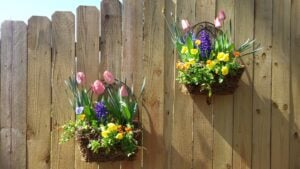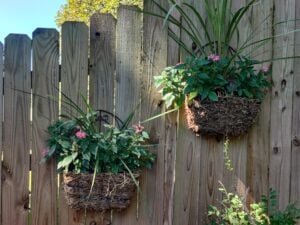Author: Alex Delaney
Winter brings dull skies and a duller landscape. But you can brighten your yard in just a few easy steps. By utilizing the instructions below, you will not only add Winter color, but you will also have a nice, colorful head start on a beautiful Spring!
These steps can be used for planters or garden beds. But for our purposes here, we are creating colorful planters that will bloom most of the year.
For your Spring bloomers and a colorful winter, start your pots in the Fall. This will allow blooms through most of the winter, and a gorgeous display for early Spring.

Pay attention to color balance, growth rates and height. The taller plants should go in the middle back of the pot for wall or fence hanging planters, or in the center for a round pot. Shorter plants, and trailing plants will go in the front.
1) Mix half potting soil, 1/4 peat moss, 1/4 organic manure. You can use just potting soil, but for better blooms, you’ll want to make your own mix.
2) Make sure you use a pot that has drainage holes, or, for plastic-lined moss baskets, puncture several drainage holes.
3) Place about 2 inches of gravel or rocks at the bottom of your pots. This will help with drainage.
4) Fill your pots about 1/3 way up with your potting soil mixture.
5) Place a mixture of Spring blooming bulbs in the soil and cover. Put two daffodils at the back of the pot, or in the center, if you are using a round pot. Place several tulip bulbs in front of the daffodils, but still toward the back as they will get tall. Place hyacinths to the sides. You can also use alliums in the back and crocuses in the front and sides.
6) Place a tall, Zone 7 hardy plant at the middle back of the pot (center if a round pot). This will give your pot height. I prefer a spiky plant. Some evergreen grasses will work.
Note: While placing plants, make sure to provide room between for the bulbs to grow.
7) Place snapdragons, Swiss chard, or other medium height winter-hardy plants in the middle sections, secure with soil.
8) Place low growing winter-hardy plants, such as pansies and violas in the middle. Pack your dirt mixture around them.
9) Tuck some creeping Jenny or thyme in the front. These can stay in the planter throughout the year and will become fuller, eventually creating a nice spill that will cover the front of the planter.
The pansies and snapdragons will bloom most of the winter in Atlanta, and the spiky center plant will add interest. If a cold spell freezes the top of the pansies, the plant will regenerate. You can cut off any browned sections, but it isn’t necessary.
After the Spring blooms have faded, you are ready to replace the pansies for a summer bloomer.
1) Dig out the pansies, and bulbs, while keeping the spiky plant and the creeping Jenny or thyme. Save the daffodils and hyacinths for planting in your yard as they will come back every year. You can discard the tulips. They lose strength and will not bloom well for a second year.
2) Replace the lost soil with freshly mixed potting soil as you did in the Fall, leaving room for the plants.
3) Chose your plants. For your Summer bloomers, the sky is the limit. Make sure you chose annuals, or slow-growing perennials. I prefer pentas for the taller bloom as they are great repeat bloomers, easily found at Home Depot, or Lowes, and come in a variety of colors.
For the shorter bloom, I rely on petunias which will also spill over the sides of the planter.
4) As in the Fall, plant your taller bloomers, pentas in this case, toward the back and middle, and petunias, or other lower grower in the front, careful not to disturb the Creeping Jenny, or Thyme.
That’s it. You now have a year-round blooming planter that takes two short planting sessions to maintain.
